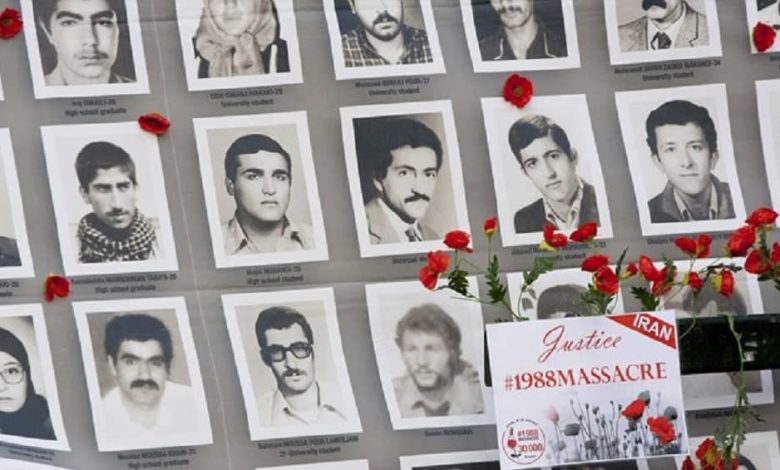Iran: “The MEK Woman Chanted Anti-regime Slogans Once Seeing the Noose” Ex-prisoner Testifies at Noury’s Trial

Written by
Shamsi Saadati
“I heard the guards speaking of a woman who chanted anti-regime slogans once she saw the noose,” Amir Hoshang Atbaie told the prosecutor at Hamid Noury’s trial on Friday, February 11.
Friday marked the 66th session of Hamid Noury’s trial. Noury, an Iranian prison official, was apprehended in 2019 upon landing in Sweden for his role in the 1988 massacre of over 30,000 political prisoners, mainly members, and supporters of the Mujahedin-e Khalq (MEK) organization. During this genocide, Noury worked as deputy prosecutor of Gohardasht prison in Karaj, where thousands of political prisoners were sent to the gallows by the “Death Commission.”
Atbaie, a supporter of the Tudeh (Communist) Party of Iran, was arrested in 1983 once the regime banned the group from political activities. He had previously testified during Noury’s 61st session on January 24. He gave harrowing accounts of large trucks taking bodies of executed prisoners out for days. During Friday’s session, Mr. Atbaie answered Noury’s lawyer and the prosecutor’s questions.
“You told us that the truck came once or twice a week,” asked the defendant’s lawyer. “No, they came once or twice a day,” Atbaie responded.
On January 24, Atbaie had told the court: “For 12 consecutive nights, I saw a refrigerator truck and two guards for five nights. Imagine the noise of dropping something in a metal container. I heard the sound until the truck was filled with layers of bodies.”
“That day, I saw the most horrible scene in my life that still haunts me to this day. Through the window, I saw the two guards going on the top of the truck. I could see them moving something to free up some space. Suddenly, I realized they were moving bodies. They were holding to limbs of dead bodies, moving them around,” he said.
In the earlier session, Atbaie had also told the court about hearing the kangaroo trials by Death Commission in Gohardasht. The “Death Commissions” were formed following a fatwa by the Iranian regime’s supreme leader, Ruhollah Khomeini, in 1988, sentencing to death all those who refused to bow to the ruling theocracy and disavow the MEK. Tehran’s Death Commission in Gohardasht only asked MEK prisoners whether they still harbor support for the group. A ‘yes’ was sufficient to seal the fate of the prisoner.
“Every day, we went to this cell to hear the [trials]. It was a matter of life and death for us too. We knew they would come for us. The cell was full of prisoners, and the guards perhaps heard the noises,” Atbaie said.
The 1988 Massacre of Political Prisoners in Iran: Eyewitness Accounts, Asghar Mehdizadeh
“Suddenly, we saw Faraj, a guard, enter the cell. Since the executions were happening, no guard had entered our [Marxists] cell. Faraj referred to a bigger prisoner than others and said: ‘your weight is ideal.’ He was referring to execution; we were all shocked.”
Atbaie then answered a question by the Judge about the mass execution of MEK supporters and what he heard in the cell next to the commission’s room.
“There are two theories. First, the trials were held in the cell during the first days of sending the MEK members to gallows. Secondly, perhaps they were taking care of those who were from Karaj. Before bringing the MEK members to trial, we could hear officials and guards talking,” he said.
“During the executions, I heard the officials and guards sharing the hanging scenes. There were no prisoners in their room, apparently. One thing that I heard and was very shocking was about a woman from the MEK. When the woman saw the noose, she began chanting anti-regime slogans, they said.”
Background
In 1988, Khomeini saw the MEK and its progressive interpretation of Islam as a serious threat to his reign and ideology. Hence, he decided to eliminate everyone unwilling to submit and choose fate over faith. The entire regime would prefer those tens of thousands of youth surrender to the regime and return to their families with the message that dissent against Khomeini is futile. Instead, these men and women stood tall and chose to die for an ideal that would live on to inspire love, equality, and prosperity for generations to come. The uprisings today in Iran show that the message and spirit of those executed in 1988 lives on and that they did not die in vain.
Indeed, Khomeini’s designated, and later sacked, heir, the late Ayatollah Hossein Ali Montazeri, told members of the Death Commission on August 14, 1988, “The People’s Mojahedin are not individuals; they are an ideology, and a world outlook. They have logic. It takes the right logic to answer wrong logic. You cannot rectify wrong with killings; you only spread it.”

